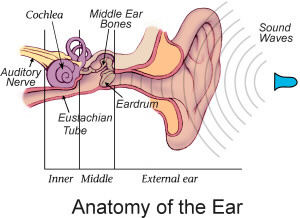 The outer ear is made up of the earlobe and ear canal, the earlobe helps direct sound from the environment into the ear canal and towards the eardrum.
The outer ear is made up of the earlobe and ear canal, the earlobe helps direct sound from the environment into the ear canal and towards the eardrum.
The middle ear is made up of the eardrum and the three tiny bones called ossicles, these three small bones move sound waves from the outer ear to the inner ear. The vibration of the ear drum causes each of the middle ear bones to vibrate in succession, directing sound to the inner ear. The area behind the middle ear is the inner ear, sound vibrations from the middle ear are transmitted to the cochlea.
The cochlea is a bone shaped like a snail’s shell it is filled with fluid and thousands of tiny hair-like nerves. Vibration makes the fluid in the cochlea move, which makes the hair move, the hairs are attached to a bundle of nerves called the Eighth Cranial Nerve this auditory nerve sends messages to the brain to process the sound the brain translates the sound for us to hear.
Types of Hearing Loss
Hearing loss is the partial or extreme loss of a person’s ability to receive information by listening. People can have a varying degree of hearing loss. Hearing loss is usually classified as conductive or sensorineural or mixed which is a combination of both..
Conductive Hearing loss can be acquired or congenital. Hearing loss often occurs with middle ear infection (otitis media) and ostosclerosis (abnormal growth of bony tissue in the middle ear). Many conditions of this type can result from fluid build-up in the middle ear as a result of colds, allergies, a perforated eardrum, impacted earwax, ear canal infection and the absence or malformation of a person's ear canal, middle ear or outer ear. This typically results in one's inability to discern faint sounds, and conversations may sound muffled or distant.
Sensorineual Hearing loss can also be acquired or congenital and is caused by malfunction of the cochlea. Congenital sensorineural hearing impairment may occur due to genetic factors, premature birth, or lack of oxygen at birth. The degree of hearing loss in a child with a sensorineural hearing loss can vary from a mild loss to a profound hearing loss. The most common Sensorineual hearing loss is Prebycusis, which can be described as an age related deafness.










